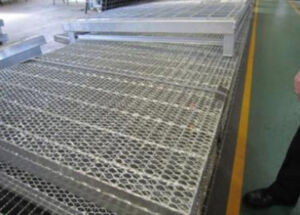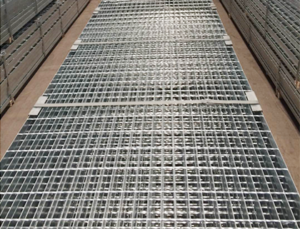In the steel grating industry, there are two main types of specifications: industry standard and custom. Industry standard specifications are pre-defined and widely used, while custom specifications are tailored to specific needs. This article will compare and contrast the two, exploring the benefits and drawbacks of each.
Industry standard steel grating specifications are established by industry organizations and are meant to provide uniformity and consistency across the board. They are often based on extensive research and testing, ensuring that the grating meets certain quality and performance standards. Custom specifications, on the other hand, are developed to meet unique requirements that may not be addressed by industry standards.
One of the key differences between industry standard and custom specifications is the level of flexibility they offer. Industry standard specifications are rigid and may not be suitable for specialized applications. Custom specifications, however, can be tailored to fit specific dimensions, materials, and load requirements, providing a more precise solution for the intended use.

When it comes to cost, industry standard specifications are generally more cost-effective due to mass production and standardized processes. Custom specifications, on the other hand, may involve higher costs as they require specialized manufacturing and engineering. However, the long-term benefits of a custom solution may outweigh the initial investment.
In terms of lead time, industry standard specifications are readily available as they are produced in large quantities. Custom specifications, on the other hand, may take longer to produce as they involve customization and approval processes. It’s important for businesses to consider the time factor when choosing between the two options.
Quality control is another important factor to consider. Industry standard specifications are often subject to strict quality control measures to ensure consistency and reliability. Custom specifications also undergo quality checks, but the level of control may vary depending on the manufacturer and the complexity of the custom requirements.
When it comes to installation and maintenance, industry standard specifications are generally easier to work with due to their standardized nature. Custom specifications may require more intricate installation processes and specialized maintenance procedures. Businesses should factor in these aspects when making a decision.
In terms of availability, industry standard specifications are widely available from various manufacturers and suppliers. Custom specifications may be limited to specific providers who have the capability to fulfill custom orders. Businesses should assess the availability of the required specifications before making a decision.
Another consideration is the level of support and expertise offered by manufacturers. Industry standard specifications are well-understood by manufacturers and installers, which means there is a wealth of knowledge and experience available. With custom specifications, it’s important to ensure that the manufacturer has the expertise to design, produce, and support the custom solution.
From a regulatory standpoint, industry standard specifications are more likely to meet industry regulations and standards, as they are designed with compliance in mind. Custom specifications may require additional validation to ensure they meet the necessary requirements. It’s crucial for businesses to adhere to relevant regulations when choosing the appropriate specifications.
In conclusion, both industry standard and custom specifications have their own advantages and limitations. The choice between the two depends on the specific needs of the project, including budget, timeline, customization requirements, and industry regulations. By carefully evaluating these factors, businesses can make an informed decision that aligns with their objectives and ensures the optimal performance of the steel grating.

The steel grating industry standard vs. custom specifications debate is an important consideration for businesses looking to invest in steel grating solutions. Understanding the differences between the two options is crucial for making an informed decision that aligns with the project’s requirements. By weighing the benefits and drawbacks of industry standard and custom specifications, businesses can determine the most suitable approach for their needs.
Steel grating industry standard specifications provide a baseline for quality and performance, offering a reliable option for general applications. However, custom specifications offer a tailored solution for specialized requirements, providing a more precise and effective solution. By comparing the two options, businesses can determine the best fit for their specific project needs.
The debate between steel grating industry standard and custom specifications extends to various aspects, including cost, lead time, quality control, installation, availability, and regulatory compliance. Each of these factors plays a crucial role in the decision-making process, requiring careful consideration to ensure the chosen specifications align with the project’s objectives and constraints.
When evaluating the cost aspect of steel grating specifications, businesses must consider the long-term benefits of custom solutions compared to the initial investment. While industry standard specifications may offer cost-effective options, custom specifications can provide tailored solutions that enhance performance and longevity, ultimately delivering greater value over time.
Lead time is another critical factor to consider when choosing between industry standard and custom specifications. While industry standard specifications are readily available, custom specifications may take longer to produce due to the customization process. Businesses should assess their timeline and project requirements to determine the most suitable option.
Quality control measures are essential for ensuring the reliability and performance of steel grating solutions. Industry standard specifications are subject to rigorous quality checks, providing a level of assurance for users. Custom specifications also undergo quality control, but the extent of the measures may vary, requiring businesses to evaluate the quality assurance processes of potential suppliers.
The ease of installation and maintenance is an important consideration for businesses, as it can impact the overall project timeline and costs. Industry standard specifications are designed for ease of use and maintenance, whereas custom specifications may require specialized installation and upkeep. Businesses should assess the practical implications of these differences when making a decision.
Availability of the required specifications is a key consideration, especially for projects with specific timeline and sourcing requirements. Industry standard specifications are widely available from various suppliers, while custom specifications may be limited to specialized providers. Businesses should ensure that the chosen specifications align with their availability needs.
The level of support and expertise offered by manufacturers is crucial for the successful implementation of steel grating solutions. Industry standard specifications benefit from widespread knowledge and experience, whereas custom specifications require specialized expertise for design, production, and support. Businesses should consider the manufacturer’s capabilities in relation to their custom requirements.
Regulatory compliance is a non-negotiable aspect of steel grating specifications, as it ensures the safety and suitability of the solutions for their intended applications. Industry standard specifications are designed with compliance in mind, while custom specifications may require additional validation to meet industry regulations. Businesses should prioritize regulatory adherence when evaluating their options.
In summary, the choice between steel grating industry standard and custom specifications requires a comprehensive assessment of various factors, including cost, lead time, quality control, installation, availability, support, and regulatory compliance. By carefully evaluating these aspects, businesses can make an informed decision that aligns with their project needs and objectives.
The debate between steel grating industry standard and custom specifications is a critical consideration for businesses seeking the most suitable solution for their projects. By understanding the differences and implications of each option, businesses can make informed decisions that optimize the performance, longevity, and value of their steel grating investments.
Steel grating industry standard specifications offer a reliable baseline for quality and performance, providing a cost-effective and readily available option for general applications. However, custom specifications deliver tailored solutions for specialized requirements, offering precise and effective solutions that enhance project outcomes.
The comparison between steel grating industry standard and custom specifications encompasses various critical factors, including cost, lead time, quality control, installation, availability, support, and regulatory compliance. Each of these aspects plays a vital role in the decision-making process, requiring careful consideration to ensure the chosen specifications align with the project’s objectives and constraints.
When evaluating the cost aspect of steel grating specifications, businesses should consider the long-term benefits of custom solutions in comparison to the initial investment. While industry standard specifications may provide cost-effective options, custom specifications can offer tailored solutions that enhance performance and longevity, ultimately delivering greater value over time.
Lead time is another crucial factor to consider when choosing between industry standard and custom specifications. While industry standard specifications are readily available, custom specifications may take longer to produce due to the customization process. Businesses should assess their timeline and project requirements to determine the most suitable option.
Quality control measures are essential for ensuring the reliability and performance of steel grating solutions. Industry standard specifications are subject to rigorous quality checks, providing a level of assurance for users. Custom specifications also undergo quality control, but the extent of the measures may vary, requiring businesses to evaluate the quality assurance processes of potential suppliers.
The ease of installation and maintenance is an important consideration for businesses, as it can impact the overall project timeline and costs. Industry standard specifications are designed for ease of use and maintenance, whereas custom specifications may require specialized installation and upkeep. Businesses should assess the practical implications of these differences when making a decision.
Availability of the required specifications is a key consideration, especially for projects with specific timeline and sourcing requirements. Industry standard specifications are widely available from various suppliers, while custom specifications may be limited to specialized providers. Businesses should ensure that the chosen specifications align with their availability needs.
The level of support and expertise offered by manufacturers is crucial for the successful implementation of steel grating solutions. Industry standard specifications benefit from widespread knowledge and experience, whereas custom specifications require specialized expertise for design, production, and support. Businesses should consider the manufacturer’s capabilities in relation to their custom requirements.
Regulatory compliance is a non-negotiable aspect of steel grating specifications, as it ensures the safety and suitability of the solutions for their intended applications. Industry standard specifications are designed with compliance in mind, while custom specifications may require additional validation to meet industry regulations. Businesses should prioritize regulatory adherence when evaluating their options.
In summary, the choice between steel grating industry standard and custom specifications requires a comprehensive assessment of various factors, including cost, lead time, quality control, installation, availability, support, and regulatory compliance. By carefully evaluating these aspects, businesses can make an informed decision that aligns with their project needs and objectives.

